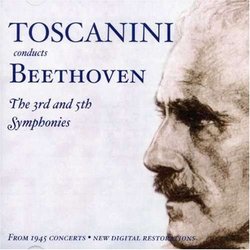CELEBRATING WAR'S END
Richard Goldberg | 03/26/2006
(4 out of 5 stars)
"First, there needs to be a correction: these performances are from 1945 (May 18th for Beethoven's 5th & September 1st for the 3rd), celebrating VE and VJ Day respectively. Both are quite good and reccommended. I am familiar with the 1933 NY Phil. performance of the 5th, and give the edge to that. However, the 1939 broadcast of the 5th and the 1953 broadcast of the 3rd are the finest performances I know of. Kleiber (both father and son) have great propulsion in the first movement of the 5th but don't carry thru the other three. As to the "Eroica", only George Szell comes close (very) to holding you from start to finish."
Toscanini in Highly Intense Performances - Even for Him!
Doug - Haydn Fan | California | 06/30/2007
(5 out of 5 stars)
"These gripping performances in improved sound give Toscanini's wartime way with the heroic Beethoven symphonies 3 and 5. Here you have a chance to catch something of the genuine visceral impact Toscanini in full flight creates.
Toscanini responded to the ground-breaking nature of these works quite differently than other conductors, turning ever more to a personal confrontation - ala Jacob wrestling with the angel - with the fiercely bound compositional Gordian knots binding the works' drama; away from the work's extroverted and expansive architecture, their effusive and optimistic sentimental lyricism. Although there will always be those who just out and out cannot handle this conductor's drive and passion, I personally find it revelatory, and one of the joys of collecting records. One hears a great artist (Toscanini) struggling with the richness of the music, its extraordinary concentration. Toscanini challenges the listener to follow his vision of these works, arrived at after many decades of performance, and most closely allied to the late quartets. Toscanini the string player here frequently calls to mind the intellectual force of Beethoven's late masterpiece, The Grosse Fugue. Compared to most readings Toscanini's with their inescapable logical impetus seem almost like Black Holes - unswervingly inward-looking, relentless and unflinching in organization.
There is a strong element of the experimentor, a term perhaps more needed in discussions of Toscanini. These performances form part of a life-long recherche: to dismiss such playing as perfunctory or too fast is more than an injustice, it's a blunder.
If you appreciate Toscanini this CD offers some of his most profound and exploratory readings. Buy it before it disappears!"
Two legendary concert performances!
Hiram Gomez Pardo | Valencia, Venezuela | 11/15/2005
(5 out of 5 stars)
"The Fifth Symphony was recorded on April 9 1933. The date is extremely important. His febrile temperament looks like the delicate and unstable state of the things in the world. The Italian Master travels constant and eagerly. And despite the genius blossoms, illuminating the score in every one of his musical tours, he is son of his Age and the dark shadows that waggle on the world do not announce limpid horizons. This reading express eloquently this supreme conviction. Beethoven 's personality added with this universal patrimony as the Fifth Symphony represents, has constituted much more than a simple device of artistic expression. The eighty per cent of the mankind still is far to understand the richness and the whole significance of this mythic work. The fierceness and sharp dissonances, the visible contrast between the verticality (fate) and horizontality ( the human will) are confronted over and over, and it is precisely the triumph of the will (in the Greek meaning) what it confers this Symphony its enviable and supreme place.
The Eroica recorded in 1939, remains possibly as my favorite interpretation of all the previous or later versions of the Italian Master. It is loaded of such visceral and mercurial conviction and steeled dignity in the Funeral March; filled with sublime expressiveness and energy that must be included between the supreme versions ever made about this colossal and milestone work.
So there is more than a reason to acquire this invaluable historic document. There must not be any single doubt about it.
Finally I would like to finish with the final statement written by Fürtwangler to a friend in a letter:
"Will it be that Beethoven failed to us, or on the contrary were we who failed to him?"
"


 Track Listings (8) - Disc #1
Track Listings (8) - Disc #1